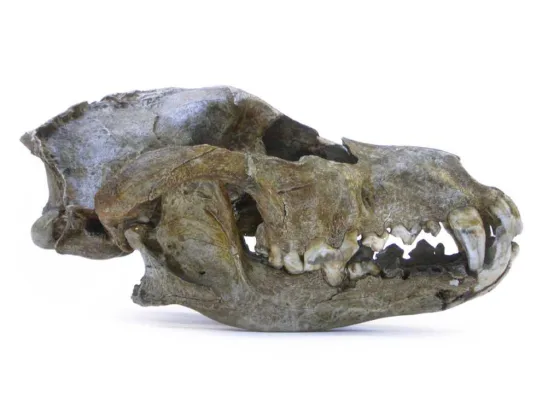
According to a recent study, an international team of researchers has discovered what they believe to be the first dog in the globe. This huge, toothy canine lived 31,700 years ago and fed on horse, musk ox, and reindeer.
Since the second-oldest known dog, discovered in Russia, dated to 14,000 years ago, the new find may push back the dating for the first dog by 17,700 years.
Researchers believe that the Aurignacian inhabitants of Europe in the Upper Paleolithic era first tamed dogs based on the earlier ancient dog remains that were discovered at Goyet Cave in Belgium. This civilization is easily identifiable by its fine jewelry and sophisticated tools, which are often adorned with carvings of large game.
If prehistoric canines were being bred today, they would undoubtedly take first place in the strength and biting ability categories.
Germonpré, a paleontologist at the Royal Belgian Institute of Natural Sciences, said that although the ancient dogs were similar in build to the Siberian husky, they were bigger in stature, maybe on par with giant shepherd dogs.
Researchers examined 117 skulls of modern and extinct big canids (which includes dogs, wolves, and foxes) for research that has been approved for publication in the Journal of Archaeological Science.
The skulls of Paleolithic dogs were somewhat smaller than modern wolf skulls, and skeletal study showed that “the Paleolithic dogs had larger and shorter snouts and significantly wider brain cases than fossil and recent wolves.”
After analyzing their DNA, scientists found that all canids had “a great level of genetic variety,” indicating that wolf populations were considerably bigger in the past.
The oldest dogs, according to the isotopic study of their bones, ate horse, musk ox, and reindeer but not fish or shellfish. The researchers speculate that the Aurignacians could have given their dogs scraps of meat from their hunts of large animals and their catches of fish at particular periods of the year.
Germonpré theorizes that ancient humans may have started domesticating dogs after killing a mother wolf and bringing her offspring into human society. Recent research on silver foxes has shown that morphological modifications may be achieved in as few as 10 generations of breeding when only the tamest offspring are preserved and cared for.
Even the first dogs had to work for their food.
She speculated that the dogs may have been utilized for locating, hunting, and transporting games. “The dogs may have been used as pack animals and transportation arranged that way. As an added layer of complexity, the dogs may have been maintained for any number of reasons, including as a companion animal, a source of food, or even as a ritual sacrifice.”

The idea that a toddler and a dog lived in Chauvet Cave, France, 26,000 years ago is supported by the discovery of human and canine footprints there. Torch wipes accompanying the tracks imply the youngster carried a torch while exploring the dark hallways followed by a dog.
Canadian anthropologist and evolutionary scientist at Pacific Identifications, Inc. Susan Crockford said to Discovery News, “this is a significant article.”
But Crockford is skeptical that the Aurignacians were the ones to domesticate canines. She believes suggests dogs may have experienced “self-domestication” from wolves more than once across history, which might explain why the animals emerge and then suddenly vanish from the archaeological record.
Crockford describes the mechanism that may have occurred in her book Rhythms of Life: Thyroid Hormone and the Origin of Species. She hypothesizes that the genes regulating thyroid rhythms, which make it possible for humans to respond to changing environmental circumstances, may eventually lead to the emergence of whole new species.
She speculated that “for these Paleolithic-age canids, the process got started and then halted,” leaving some wolves with certain attributes of early dogs but not all of them.
Germonpré calls Crockford’s idea “extremely fascinating,” therefore she clearly agrees with it. She hopes additional information will come to light in the future concerning these extremely early canines. Detailed research on their teeth and jaws is already in the works.